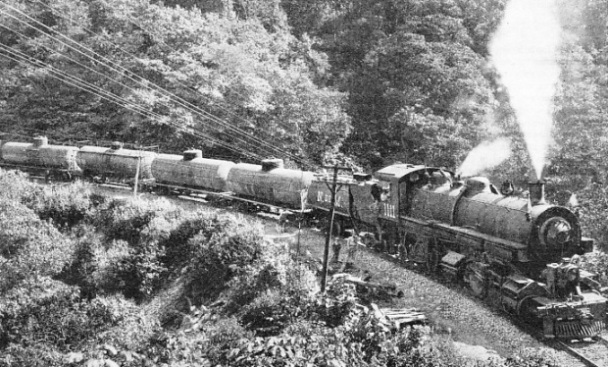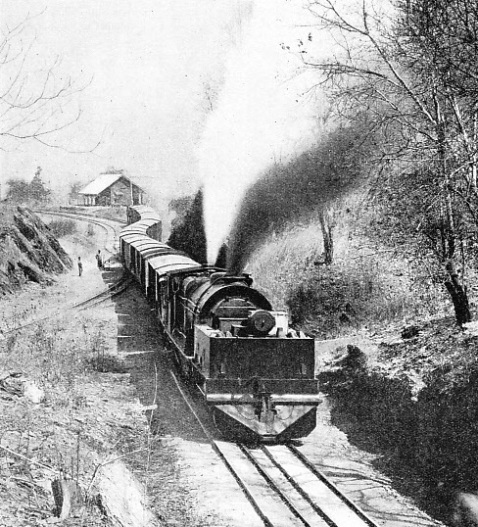
© Railway Wonders of the World 2012-


Part 42


Part 42 of Railway Wonders of the World was published on Friday 15th November 1935.
This issue contained a colour plate Passing at Speed. The colour plate was attached to page 1325. This plate had previously appeared as the cover to
part 34.
The Cover
The cover this week shows a Southern Railway “Lord Nelson” class engine, “Howard of Effingham”, running near Knockholt in Kent, and hauling a Dover express. Between London and Tonbridge on this route speeds are restricted; from Tonbridge to Dover the average speed is normally over sixty miles an hour.
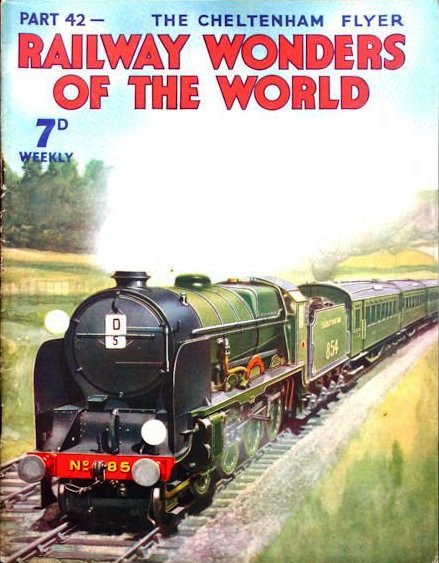
Switches and Crossings (Part 2)
The construction of switches and crossings, concluded from part 41.
(Pages 1317-1322 )
Passing at Speed
PASSING AT SPEED. An unusual view from the tender of a goods engine showing an approaching Great Western express between Reading and Didcot. The locomotive heading the express is of the “Saint” Class. The leading dimensions are: cylinders (two) 18½ in by 30 in; total heating surface, 2,104 sq ft; grate area 27.07 sq ft; diameter of coupled wheels,
6 ft 8½ in; working pressure, 225 lb; tractive effort, 24,395 lb; and weight of the engine, in working order, without tender, 72 tons.
The “Saint” is No. 2934 “Butleigh Court”.
The colour plate was previously used as the cover for part 34.
(Attached to page 1325)
Burma’s Metre-Gauge System
Burma has a remarkable metre-gauge system, with over 2,000 miles of track open. The narrow-gauge lines handle a dense suburban traffic round Rangoon, one of the British Empire’s great ports, and have a main through route 900 miles in length. The Burma State Railways also possess some of the most powerful locomotives built for this gauge. The general standard of lines in Burma is comparable with that of many more extensive systems with a broader gauge. At Rangoon over 150 trains arrive and depart daily, and trains load up to twelve or fourteen coaches. This article is the thirteenth in the series Railways of the Empire.
(Pages 1329-1331 )
The Rome-Naples “Direttissima”
The ancient Romans specialized in building straight roads. The modern Italians build straight railways, or routes that avoid deviations as far as possible. One of the latest of these direct lines - “Direttissima” - has been constructed between Rome and Naples. The line brings the two cities within 134½ miles of each other, and the new line is shorter than the older route by thirty-five and a half miles. But this method of construction involves numerous difficulties. Rivers and mountains have had to be conquered. The number of bridges and viaducts on the new Rome-Naples route totals over forty of major importance, and 640 of smaller span. This amazing line is electrified, and the completion of the great work is a tribute to the engineers and to the enterprise of modem railway authorities.
(Pages 1332-1336 )
The Campi Flegrei Tunnel
THE CAMPI FLEGREI TUNNEL the new direct railway route between Rome and Naples has a length of 1,939 yeards. The construction of the Rome-Naples “Direttissima” included some twenty-one miles of tunnelling on the 134½ miles line.
(page 1332)
The Story of the Locomotive
(Top) A “MOGUL” BUILT IN 1912 for freight service by the Caledonian Railway. This
2-6-0 engine has cylinders 19½ in by 26 in, the diameter of the coupled wheels is 5 ft, and the total wheel base is 24 ft. The grate areas is 20½ sq ft, and the boiler pressure 160 lb per sq in. The weight of the engine is 54¼ tons, and the tender 37¼ tons. The latter can carry 3,000 gallons of water and 4½ tons of coal.
(Middle) ON THE EAST KENT RAILWAY. This
0-6-0 locomotive, built by Sharp, Stewart and Co in 1891, was formerly owned by the South Eastern & Chatham Railway. The East Kent Railway has seven locomotives in operation on its nineteen miles of standard gauge tack. The system is one of the few remaining independent lines in Great Britain. It serves the Kentish coalfields, and the principal traffic is freight.”
(Bottom) “AN “ATLANTIC” EXPRESS ENGINE, formerly of the North Eastern Railway, hauling an LNER train near Barkston, Lincolnshire. Designed in 1911, these three-cylinder locomotives have 16½ in by 26 in cylinders, and a total heating surface, including superheater, of 2005.8 sq ft. The boiler pressure is 160 lb, and the engine alone weighs, in working order, 77 tons 2 cwt. The apparatus above the boiler is a feed-water heater.
(Page 1339)
Mexico’s Main Lines
The railways of Mexico have had to conquer difficult and mountainous territory; they represent triumphs of modern engineering in a country that knew one of the world’s earliest civilizations. To-day the lines that thread the country from end to end, and link up with the giant systems of the United States, are playing a vital part in the economic development of the country. Though they were built chiefly by British and American enterprise, the railways are controlled almost entirely by the Mexican people, and provide an efficient transport system. The article is concluded in part 43. You can read more on the railways of Mexico in Frederick Talbot’s Railway Wonders of the World (1913).
(Pages 1343-1348 )
In Central Mexico
IN CENTRAL MEXICO. A train of fuel oil tanks hauled by an oil-fired locomotive, on the line between San Luis Potosi and the port of Tampico. Oil fuel is widely used in Mexico, and the railways have a large number of oil-burning locomotives in operation.
(Page 1345)
Contents of Part 42
Switches and Crossings (Part 2)
The “Cheltenham Flyer”
Passing at Speed (colour plate)
Burma’s Metre-Gauge System
The Rome-Naples “Direttissima”
The Story of the Locomotive (4)
Mexico’s Main Lines (Part 1)
The “Cheltenham Flyer”
The “Cheltenham Flyer” is one of the world’s most famous trains. From 1932 until 1935 it held the record for the world’s fastest regular steam train, with an average timing of 71.4 miles an hour from start to stop between Swindon and Paddington. That this record has been beaten in America, notably by a Chicago-Detroit express on the Pennsylvania railroad, scheduled to cover 64.2 miles at an average speed of 75.5 miles and hour, does not make the “Cheltenham Flyer” less famous. It held the record for three years - a remarkable achievement in an age when every record is fiercely challenged. We may be sure that the GWR is fully conscious of this American gesture. This chapter includes a description of one of the most wonderful runs made in railway history - the record run of the express in 1932, when it covered 77.3 miles between Swindon and Paddington at an average speed of 81.6 miles and hour. The chapter also gives a detailed description of the route and the make-up of the train. After leaving Swindon the speed averages about eighty miles and hours for a large part of the journey. This is the twelfth article in the series on Famous Trains.
(Pages 1323-1328 )
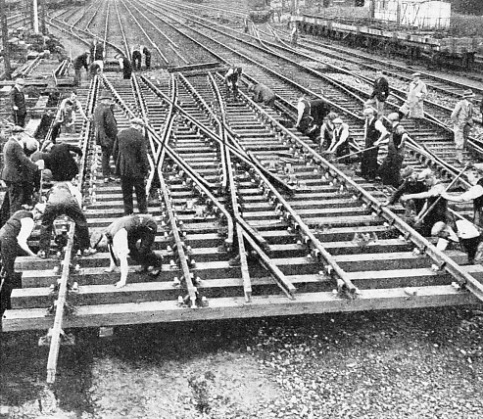
Relaying a Scissors Crossing
RELAYING A “SCISSORS CROSSING”. This unit of track, weighing 25 tons, and 100 ft in length, has been assembled at the side of the main line, and is being moved into position on ball-bearing rollers. It consists of a double cross-over road, and the complications of the centre crossing construction is clearly seen.
(Page 1319)
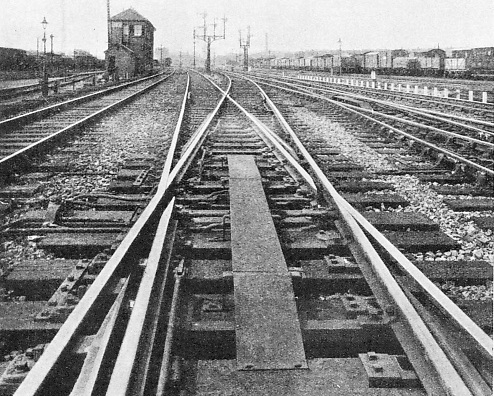
A Moveable Diamond Crossing
MOVEABLE DIAMOND CROSSINGS provide a solid path for the wheels, as shown by the right-hand rail through this crossing at Old Oak Common West Junction. The point-rails of the diamond are arranged to move like switches and are coupled together by the cranks as shown above to make them move in unison. Two are always open when the other two are closed. Locking-bars are placed alongside the running rails to ensure safety.
(Page 1320)
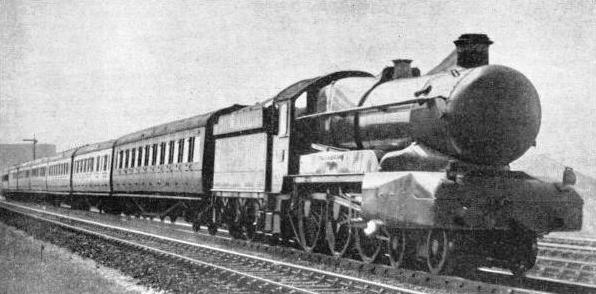
The “Cheltenham Flyer”
“MANORBIER CASTLE”, experimentally streamlined, hauling the "Cheltenham Flyer" near Sonning Cutting, Berks. The locomotive has four cylinders 16 in by 28 in, coupled wheels
8 ft 8½ in diameter, a total heating surface, including superheater, of 2,312 sq ft, and a boiler pressure of 225 lb. The tractive effort is 31,625 lb.
(Page 1323)
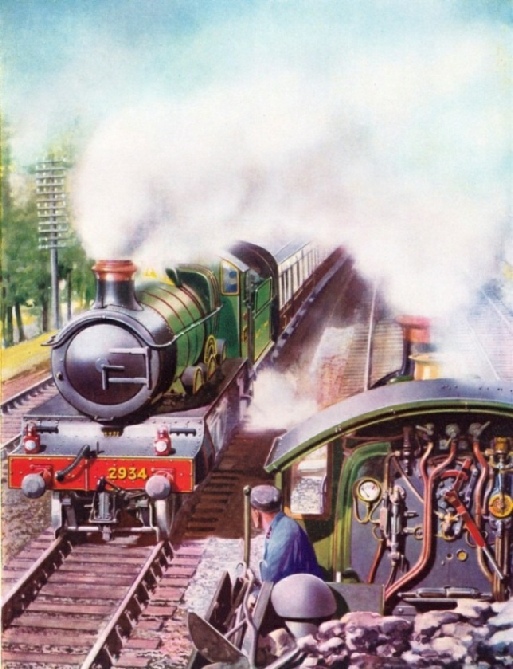
A Metre-Gauge Beyer-Garratt
THE BEYER-GARRATT articulated locomotive was introduced in 1924 to work on the Lashio branch of the Burma Railways. The type was, at the time, the most powerful in the world working on the metre gauge. The section operated by it includes lengths of continuous reverse curves of 330 ft radius, and eleven miles of 1 in 25 gradient.
(Page 1331)
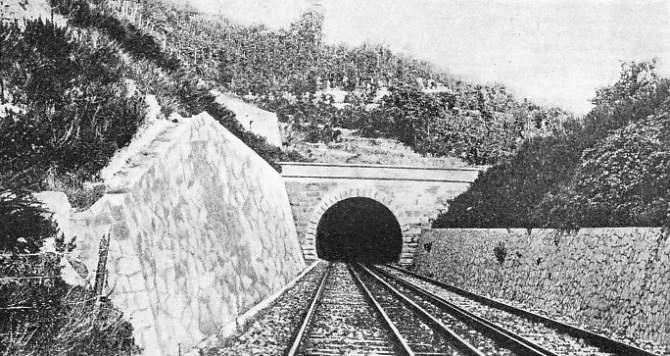
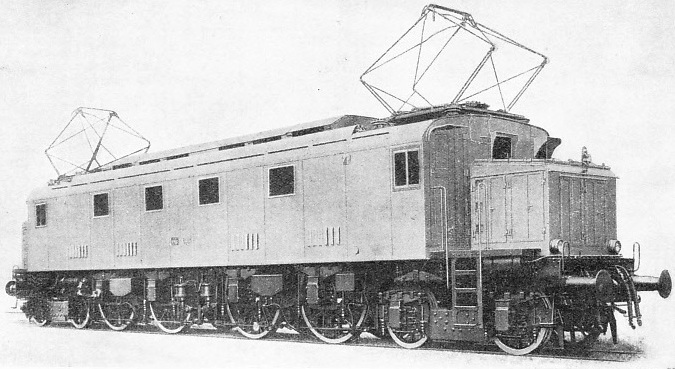
A Modern Electric Locomotive of the Italian State Railways
A MODERN ELECTRIC LOCOMOTIVE built for express work on the Italian State railways. The introduction of powerful electric locomotives on the Rome-Naples “Direttissima” has greatly improved the service on the 134½ miles journey.
(Page 1332)
The Story of the Locomotive (4)
In this chapter the developments of the steam engine from the year 1880 until the present day are fully described and the main tendencies in the construction of locomotives outlined. Though the improvements during the last fifty years are many and varied, maximum speeds of 75 miles an hour had been reached, and fast expresses hauled some 150 tons as far back as 1884. At the beginning of the twentieth century many features that are now common were introduced into locomotive practice. These included the first fire-tube superheater, which was first used on British railways in 1906. The operating principle of the superheater, which was patented by Dr Schmidt in 1900, is applied to most modern locomotives. This is the fifteenth article in the series Design and Invention. You can read more on the early part of this period in G. Sekon’s The Evolution of the Steam Locomotive (1899).
(Pages 1337-1342 )
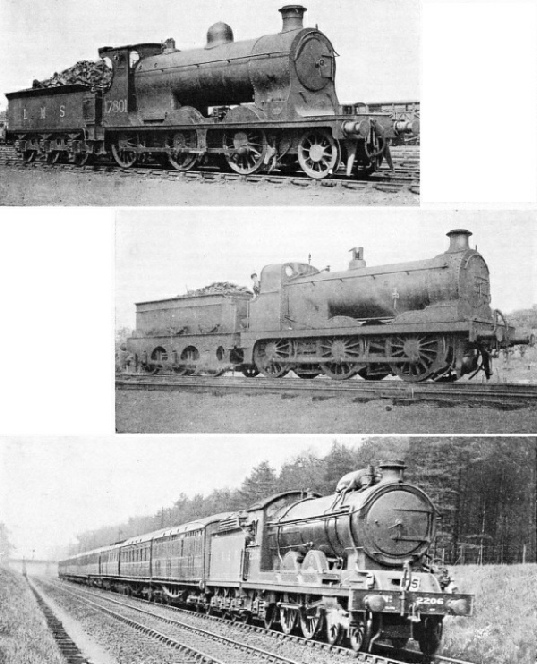
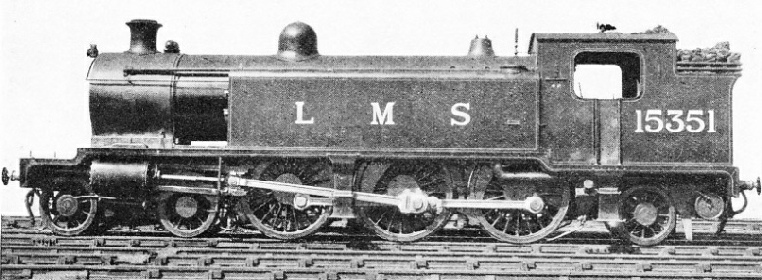
A Superheated LMS Tank Locomotive
SUPERHEATED LMS TANK LOCOMOTIVE, formerly owned by the Caledonian Railway. Cylinders measure 19 in by 26 in, diameter of coupled wheels is 5 ft 9 in, boiler pressure 170 lb per sq in, total heating surface, including superheater, 1,716 sq ft, and total weight in working order 91 tons 13 cwt. Tractive effort at 85 per cent boiler pressure is 20,704 lb.
(Page 1338)
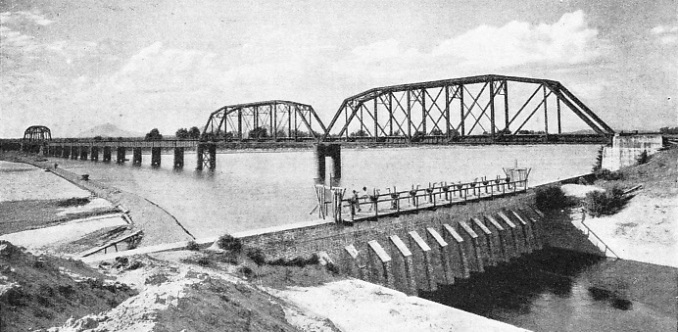
The Culiacan River Bridge
THE CULIACAN RIVER BRIDGE built by the Southern Pacific Railroad of Mexico. This rail bridge is situated near the Culiacan Junction on the west coast of Mexico. The railroad is a subsidiary of the Southern Pacific Company of USA, and controls 1,355 miles of 4 ft 8½ in gauge track.
(Page 1344)
